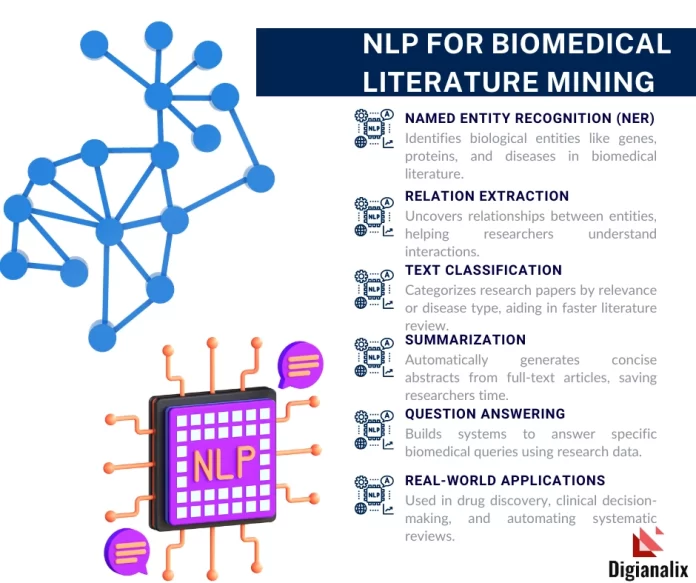Hey there, biotech and data science enthusiasts! 👋 Today, we’re diving into an exciting intersection of biology and artificial intelligence: Natural Language Processing (NLP) for biomedical literature mining. This cutting-edge field is revolutionizing how we extract knowledge from the vast sea of scientific publications. Let’s explore how you can get involved!
🧠 What is NLP for Biomedical Literature Mining?
Natural Language Processing is a branch of AI that focuses on the interaction between computers and human language. When applied to biomedical literature mining, it helps researchers:
- Extract key information from scientific papers
- Identify relationships between biological entities
- Summarize research findings
- Discover new connections across studies
🔬 Why It Matters
The volume of biomedical literature is growing exponentially. NLP tools help researchers:
- Stay up-to-date with the latest findings
- Accelerate the pace of discovery
- Identify potential drug targets
- Understand complex biological systems
💻 Key NLP Techniques in Biomedical Research
- Named Entity Recognition (NER): Identifying biological entities like genes, proteins, and diseases in text
- Relation Extraction: Discovering relationships between entities
- Text Classification: Categorizing papers by topic or relevance
- Summarization: Generating concise overviews of research papers
- Question Answering: Building systems that can answer specific biomedical queries
🚀 Getting Started with NLP in Biomedical Research
Ready to dive in? Here’s how you can get started:
- 📚 Learn the Basics:
- Python programming
- Machine learning fundamentals
- NLP concepts (tokenization, part-of-speech tagging, etc.)
- 🧰 Master Key Tools:
- NLTK (Natural Language Toolkit)
- spaCy
- BioBERT (BERT model pre-trained on biomedical text)
- PubMed API for accessing biomedical literature
- 🏋️ Practice with Datasets:
- BioNLP Shared Task datasets
- BioCreative challenge datasets
- PubMed Central Open Access Subset
- 🔍 Explore Real-world Applications:
- Drug discovery pipelines
- Clinical decision support systems
- Systematic review automation
💡 Project Ideas to Get You Started
- Build a named entity recognition system for identifying genes and proteins in research abstracts
- Develop a text classification model to categorize papers by disease type
- Create a summarization tool for generating abstracts from full-text articles
- Design a question-answering system for common biomedical queries
🌟 Future Trends and Opportunities
As you embark on your NLP journey in biomedical research, keep an eye on these emerging trends:
- Multi-modal models combining text and image data
- Graph-based approaches for knowledge representation
- Federated learning for privacy-preserving NLP in healthcare
- Integration of NLP with other omics data (genomics, proteomics, etc.)
🤔 Ethical Considerations
As you work with NLP in biomedical contexts, always keep these ethical aspects in mind:
- Data privacy and patient confidentiality
- Bias in training data and models
- Interpretability and explainability of AI decisions
- Responsible reporting of AI-generated insights
🔮 The Future is Bright!
NLP in biomedical literature mining is a field brimming with potential. As a budding biotech or data science professional, you have the opportunity to contribute to groundbreaking discoveries and improve healthcare outcomes.
So, what’s your next move? Will you start with a simple NER project, or dive into building a complex question-answering system? Share your ideas and experiences in the comments below!
Remember, every great discovery starts with a question. With NLP, you have a powerful tool to help find the answers hidden in millions of research papers. Happy mining!




